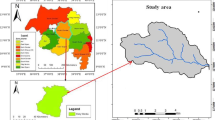Abstract
Upper Gotvand Dam is constructed on the Karun River at the south west of Iran. In this paper, 2D and 3D models of the dam together with the foundation and abutments were established, and several seepage analyses were carried out. Then, the gypsum veins that are scattered throughout the foundation ground were included in the models, and the seepage pattern, considering the dissolution law of gypsum, was analyzed. It was disclosed that the discharge fluxes obtained from 2D and 3D analyses are not similar, and the discharge flux in 3D model is about four times that of the 2D model. Also, the 3D model locates the phreatic surface somewhat higher than the 2D model. This means that the 2D model estimates lower pore water pressure pattern in comparison with the 3D model. These may be attributed to the fact that with 2D model the lateral components of vectors of seepage velocity are ignored. In the current case, the rate of increase of discharge flux due to dissolution of gypsum veins was obtained to be a thirdorder function of the aperture width. In spite of the fact that the grout curtain is designed to be about 170 m deep, however, complete dissolve of gypsum will severely increase the discharge flux through the foundation ground.
Similar content being viewed by others
References
Jeschke A A, Vosbeck K, Dreybrodt W. Surface controlled dissolution rates of gypsum in aqueous solutions exhibit nonlinear dissolution kinetics. Geochimica et Cosmochimica Acta, 2001, 65(1): 27–34
Ford D C, Williams P W. Karst Geomorphology and Hydrology. London: Unwin Hyman Ltd, 1994
Calcano C E, Alzura P R. Problems of dissolution of Gypsum in dam Sits. Bulletin of the Venezuelan Society on Soil Mechanic & Foundation Engineering, July–September, 1967, 75–80
Serafim J L, Santos A P, Matos M S. Tridimensional seepage through a dam foundation. In: Proceeding of ICOLD Lausanne. Lausanne: ICOLD, 1985
Uromeihy A, Barzegari G. Evaluation and treatment of seepage problems at Chapar-Abad Dam, Iran. Engineering Geology, 2007, 91(2–4): 219–228
Ghobadi M H, Khanlari G R, Djalaly H. Seepage problems in the right abutment of the Shahid Abbaspour dam, southern Iran. Engineering Geology, 2005, 82(2): 119–126
Ahmed A A. Stochastic analysis of free surface flow through earth dams. Computers and Geotechnics, 2009, 36(7): 1186–1190
Fredlund D G, Rahardjo H. Soil Mechanics for Unsaturated Soils. New York: John Wiley & Sons, 1993
GEO-SLOPE International Ltd. Seep3D User’s Guide. Version 1.1. Alberta: Calgary, 2002
Sadrekarimi J, Saghafi M. Stress dependent permeability effects on ground water flow. Amir Kabir Journal of Science and Technology, 2003, 4(53): 35–42
Freeze R A. Influence of the unsaturated flow domain on seepage through earth dams. Water Resources Research, 1971, 7(4): 929–942
Mahab G C E. Report of International Expert Panel on Upper Gotvand Dam & HEPP. Tehran: Mahab Ghods Consulting Engineers, 2005
Fell R, Mac Gregor P, Stapledon D. Geotechnical Engineering of Embankment Dams. Rotterdam: Balkema A A, 1992
Blyth F G H, de Freitas M H. A Geology for Engineers. 7th Edition. Oxford, UK: Butterworth-Heinemann, 1984, 87
Romanov D, Gabrovsek F, Dreybrodt W. Leakage below dam sites in limestone terrains by enhanced karstification: A modeling approach. Environmental Geology, 2007, 51(5): 775–779
Romanov D, Gabrovsek F, Dreybrodt W. Dam sites in soluble rocks: a model of increasing leakage by dissolutional widening of fractures beneath a dam. Engineering Geology, 2003, 70(1): 17–35
Author information
Authors and Affiliations
Corresponding author
Rights and permissions
About this article
Cite this article
Sadrekarimi, J., Kiyani, M., Fakhri, B. et al. Seepage analysis of Upper Gotvand Dam concerning gypsum karstification (2D and 3D approaches). Front. Archit. Civ. Eng. China 5, 71–78 (2011). https://doi.org/10.1007/s11709-010-0083-5
Received:
Accepted:
Published:
Issue Date:
DOI: https://doi.org/10.1007/s11709-010-0083-5




